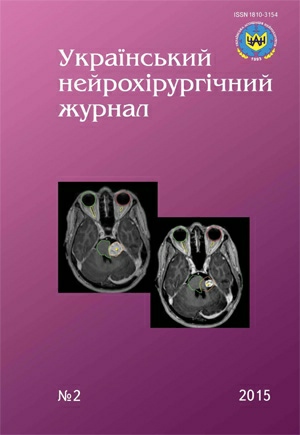Skull and brain gunshot wound during the armed conflict in eastern Ukraine. Report 1. Clinical, functional and structural features
DOI:
https://doi.org/10.25305/unj.45294Keywords:
skull and brain gunshot wounds, mine-explosive wounds, bullet wounds, blast traumaAbstract
Purpose. To study features skull and brain of gunshot wounds (SBGW) in local fighting in the East of Ukraine.
Material and methods. The results of complex examination and treatment of 790 injured persons been treated in Mechnikov Dnipropetrovsk Regional Clinical Hospital from May 25 to December 31, 2014. SBGW were diagnosed in 64 (8.1%) patients, that was 18.8% in a structure of all closed and open head injuries, 33.5% — of all gunshot wounds of different areas of the head, 63.4% — of gunshot wounds of soft tissues of different areas of the skull.
Results. SBGW mostly (in 90.6% of cases) were due to fragments of mine-explosive devices. Penetrating wounds with dura mater injury dominate (in 64.1%) among SBGW. Ricochet wounds were most common (in 50%) among SBGW in local fighting. High frequency of brain injury was due to secondary injury by skull bones fragments. In addition to traumatic brain injuries, widespread use of mine-explosive devices causes frequent occurrence (in 65.6%cases) of combined injuries of several organs and systems of the body.
Conclusions. Multiple wounds caused by fragments of explosive devices that affect several anatomical sites are the most common type of combat traumas.
References
Konovalov AN, Likhterman LB, Potapov AA, ed. Cherepno-mozgovaya travma. Klinicheskoye rukovodstvo. Moscow: ANTIDOR, 2001. Russian.
Rutledge R, Lentz C, Fakhry S, Hunt J. Appropriate Use of the Glasgow Coma Scale in Intubated Patients. The Journal of Trauma: Injury, Infection, and Critical Care. 1996;41(3):514-522. CrossRef.
Bullock M, Chesnut R, Ghajar J, Gordon D, Hartl R, Newell D, Servadei F, Walters B, Wilberger J. Guidelines for the surgical management of traumatic brain injury. Appendix II: Evaluation of Relevant Computed Tomographic Scan Findings. Neurosurgery. 2006;58(Supplement):S2-62. CrossRef.
Morris G, Marshall L. A new, practical classification of traumatic subarachnoid hemorrhage. Clinical Neurology and Neurosurgery. 1997;99:S16. CrossRef.
Babchin IS. Klassifikatsiya ognestrelnykh pronikayushchikh raneniy cherepa i statisticheskiye dannyye. In: Opyt sovetskoy meditsiny v Velikoy Otechestvennoy voyne 1941-1945 gg. Moscow: Medgiz, 1950;4:326-331. Russian.
Polishchuk NE, Starcha VI. Ognestrelnyye raneniya golovy. Kiev: TOV ToN, 1996. Russian.
Konovalov AN, Likhterman LB, Potapov AA, ed. Formalizovannaya istoriya bolezni. In: Otraslevaya nauchno-tekhnicheskaya programma S09 «Travma tsentral'noy nervnoy sistemy». Moscow, 1986-1990. Russian.
Lapach SN, Chubenko AV, Babich PN. Statisticheskiye metody v mediko-biologicheskikh issledovaniyakh s ispolzovaniyem Excel. Kiev: MORION, 2000. Russian.
Kholbek OM. O voyenno-polevykh raneniyakh cherepa. Nablyudeniye iz opyta Russko-Yaponskoy voyny. Yuryev: Tipografiya K Mattisena, 1911. Russian. [cited 2014 December 16]. Available at: URL
Babchin IS. Klassifikatsiya ognestrelnykh pronikayushchikh raneniy cherepa i statisticheskiye dannyye. In: Opyt sovetskoy meditsiny v Velikoy Otechestvennoy voyne 1941-1945 gg. Moscow: Medgiz, 1950;4:260-267. Russian.
Nechaev EA, Tutokhel AK, Gritsanov AI, Kosachev ID. [The surgical aspects of the lessons of the war in Afghanistan]. Voen Med Zh. 1991;(8):7-12. Russian. PubMed
Khilko VA, Verkhevskiy AI, Shulev YuA. Vzryvnyye povrezhdeniya cherepa i pozvonochnika. Leningrad: VmedA,1989. Russian.
The Joint Trauma System Clinical Practice Guidelines [Internet]. United States Army Institute of Surgical Research; 2014. [cited 2014 December 16]. Available at: URL.
Nevidkladna viyskova khirurhiya. Lviv: Nautilus, 2015. Ukrainian.
Downloads
Published
How to Cite
Issue
Section
License
Copyright (c) 2015 Andriy Sirko

This work is licensed under a Creative Commons Attribution 4.0 International License.
Ukrainian Neurosurgical Journal abides by the CREATIVE COMMONS copyright rights and permissions for open access journals.
Authors, who are published in this Journal, agree to the following conditions:
1. The authors reserve the right to authorship of the work and pass the first publication right of this work to the Journal under the terms of Creative Commons Attribution License, which allows others to freely distribute the published research with the obligatory reference to the authors of the original work and the first publication of the work in this Journal.
2. The authors have the right to conclude separate supplement agreements that relate to non-exclusive work distribution in the form of which it has been published by the Journal (for example, to upload the work to the online storage of the Journal or publish it as part of a monograph), provided that the reference to the first publication of the work in this Journal is included.









